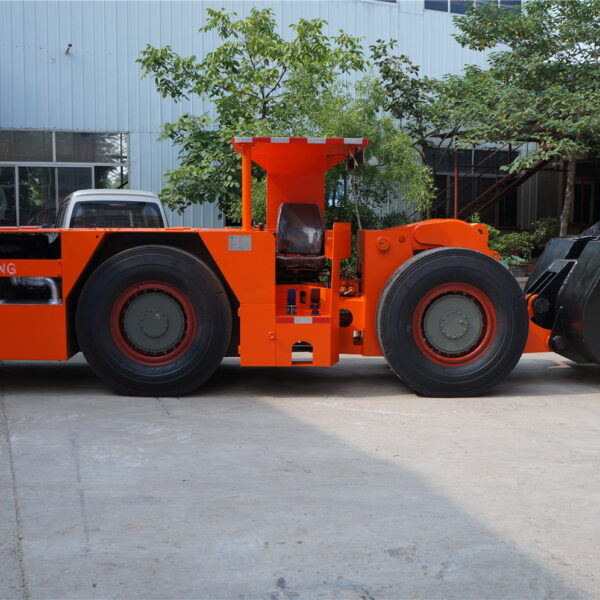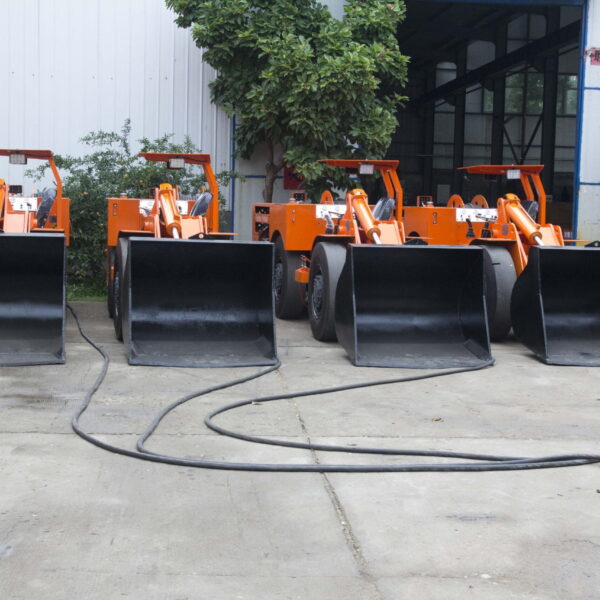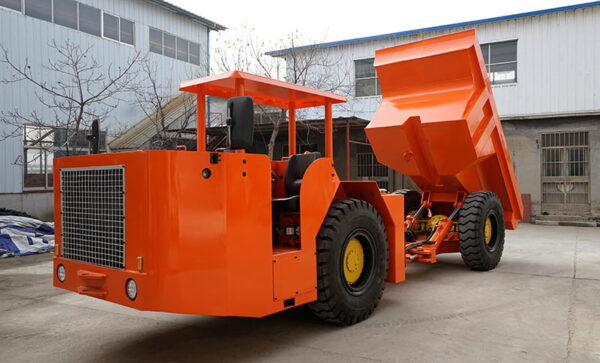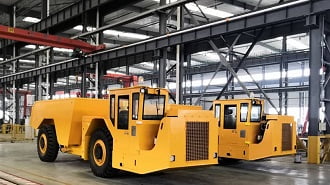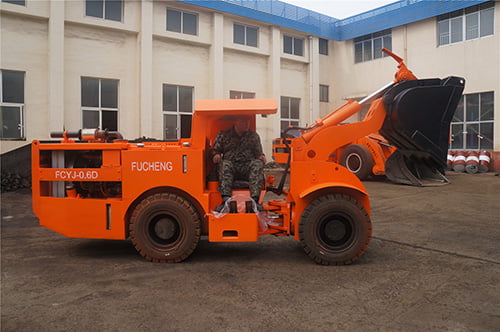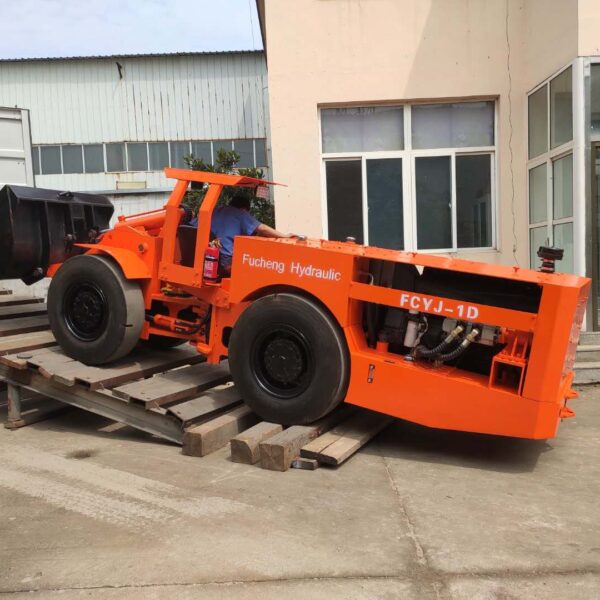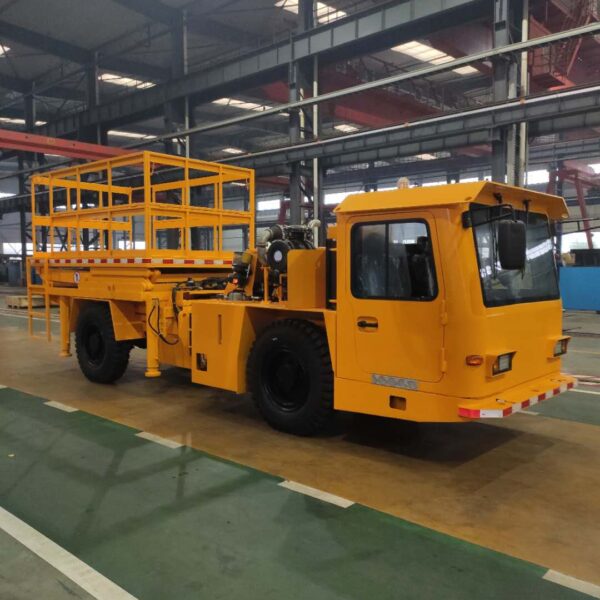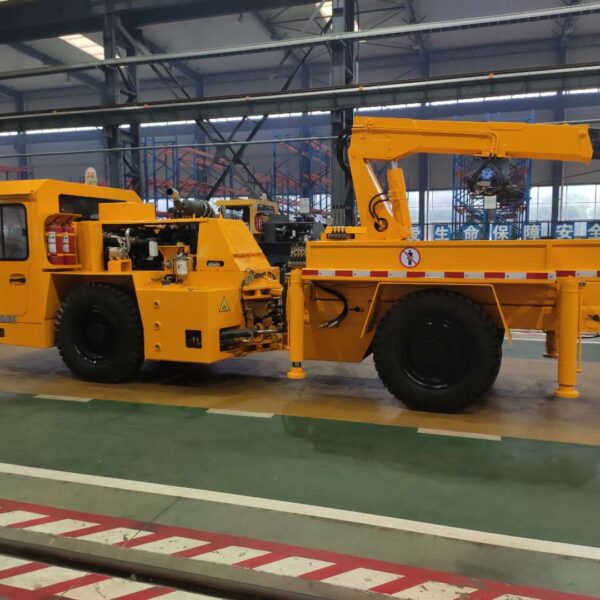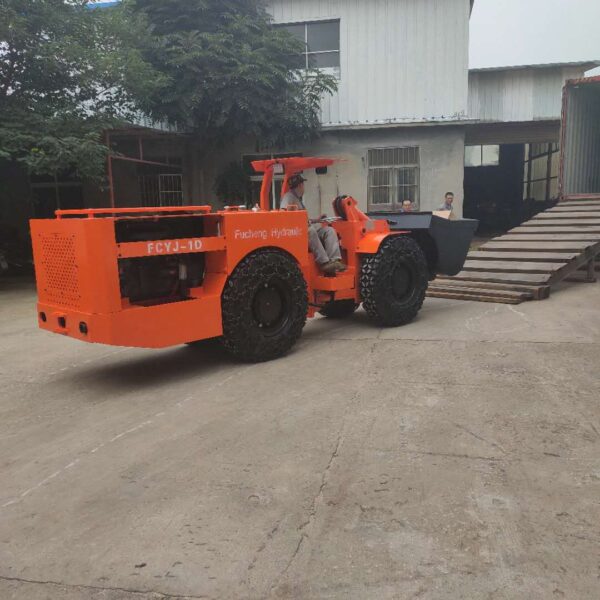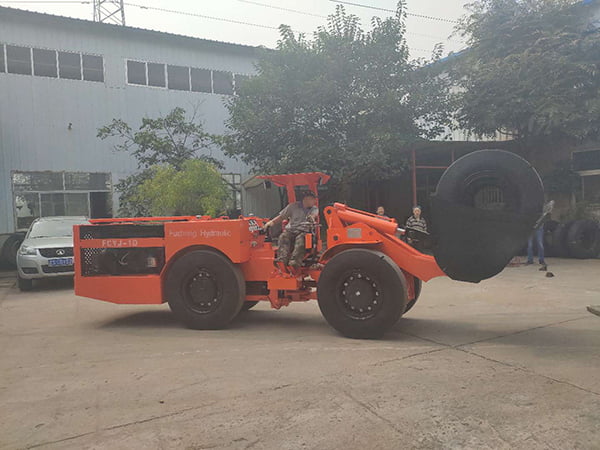Horizontal transportation in the underground mine relies heavily on load-haul dump (LHD) vehicles or underground Scooptrams. Underground mining scoop tram transport ore from the mining faces to the closest belt conveyors, dumped at unique locations. Underground mining scoop tram is adamant, maneuverable, and productive.
LHD is popular in more than 75% of the world’s deep metal mines to handle the muck from their excavations.
Working Principle of Underground Mining Scooptram
An Underground LHD has a significant role in loading underground products onto a conveyor chain or belt.
Underground mining scoop tram is typically a trackless machine with four tires and a front-end bucket for carrying and dumping bulk materials.
An LHD is lightweight and low-profile since its design suits underground mining. The benefits of joining by welding are one of the turning points for applying lightweight structures. The high load potential of welds and the design and efficiency options available significantly improve construction structure.
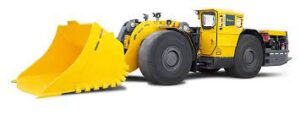
Scoop tram has a volume range of 0.6 m³ to 3 m³. Scoop tram operates in both directions, with powered steering operated by a driver who sits mostly at right angles to the vehicle’s movement.
The underground LHD machine has two different categories, diesel-powered and electric-powered LHD loaders.
The diesel engine drives the diesel-powered LHD, and the Electric LHDs, on the other hand, are powered by electric cables or other power source management.
In most cases, an asynchronous motor drives an electric LHD connected to a gate end box through a flexible cable of about 100 meters in length. Remote access is also available for these electric LHD Loaders.
The diesel engine LHDs has a high-quality advanced DEUTZ engine developed by the German company DEUTZ equipped inside all the Fucheng Vehicles. These automobiles are more efficient than electric automobiles.
However, for both underground vehicles, the pace of the automobile is mechanically regulated. A hydrostatic drive controls the transmission.
LHD Mechanism
The motor drives a hydraulically variable displacement pump connected to a hydro-motor that drives the axle through a gearbox in hydrostatic transmission. The displacement volume of the axial pump is changed to regulate the speed.
A closed-loop hydraulic transmission, parking brakes, a two-stage gearbox, and drivelines with a no-spin front axle and no-spin rear axle make up the power train.
In addition, the rear and front axles each have four multi-disc service brakes. Hydraulic pumps of various capacities are available in these vehicles. These pumps can handle tasks like hoisting, dumping, steering, braking, and cable reeling and unreeling.
An orbital steering facility is available for power steering. The orbitals (steering control valves) made by Trail-Gear all have a built-in return to center function. When the driver lets go of the steering wheel, the tires will immediately return to their original location.
Depending on the size and capability of the underground scooptram, the cable drum can handle various dimensional types of trailing cable. The system has an automated cable reeling equipped mechanism to ensure smooth operation.
A high-capacity electric motor powers the Pumps. This hydraulic pump transforms mechanical energy into hydraulic energy. It produces enough flow with enough force to counteract the load-induced pressure.
The vehicle’s front determines the machine’s effective operating range to back length. The mechanic on the right side of the Scooptram is in charge of all hydraulic operations.
A belt-driven compressor meets the air requirement for a pneumatic arrangement. In this case, the belt connects the engine and the air compressor in a belt drive system. The belt drives the pump by pulleys while the engine is off. The diameters of the pulleys decide the compressor’s speed and PSI (The pound per square inch).
Drive unit → Transmission → Hydraulic → Tire → Brake/ Others → Bucket(mining scoop)
Types of Underground Mining Scooptram
Miners need different types of underground LHD loaders depending on their needs in underground mining operations. Diesel LHDs and Electric LHDs are the two most popular types of LHDs used in underground mining.
Electric LHDs were employed in mining operations before the use of Diesel underground LHDs. Diesel LHD loaders can go anywhere and across any distance in this situation. However, electric LHDs have a restricted range of motion.
Diesel engines are adaptable power plants, especially when it comes to the project that Underground LHDs do.
They have an almost limitless operating range, a high amount of energy per mass of energy storage material (around 13 kWh/kg of fuel), a favorable power to gross vehicle weight ratio (approximately 5,6 kW/t), a low capital cost, and quick and easy refueling.
Electric LHD drives have been used in mining for more than a century, far more than diesel motors. They have some significant benefits over diesel engines. In this situation, the same advantages and disadvantages are highly dependent on how electric energy is delivered to the vehicle’s motors.
Therefore, Manufacturers have divided electric LHDs into four groups based on how electric energy is delivered to the motors.
- Onboard battery pack.
- Umbilical control cord.
- Overhead trolley line.
- Hybrid electric motor.
In Fucheng Underground electric mining scoop trams, electric supply through power cables is the most popular.
Onboard battery pack
The versatility, power density, good tractive ability, strong overload performance, and reasonably low maintenance requirements are the key advantages of battery-powered Underground LHD Loaders.
Unfortunately, their independence is reduced due to the insufficient energy storage ability of their batteries.
Umbilical control cord
Using a trailing cable to control an electric LHD is a practical choice that allows the empty vehicle’s weight more desirable than battery-powered LHDs.
Several Fucheng electric LHD models are commercially viable, with tramming capacities varying from 2 to 4 tonnes. Electric Scooptram FCYJ-2E, Fucheng’s most powerful Electric LHD, has a capacity of up to 4 tons and a bucket volume of 2 m³.
Due to the higher efficiency of electric LHD drives, these LHDs have lower-power motors than their diesel equivalents, providing comparable output. In this regard, electric loaders have a better tramming capability to installed power than diesel loaders.
Overhead trolley line
Using an overhead cable to electric power railway or trackless vehicles is a technique that has been used in underground mines for over a century.
Its applicability for trackless loading and hauling machinery, on the other hand, is limited.
Hybrid electric motor
A hybrid electric vehicle (HEV) combines a standard combustion system with an onboard refillable energy storage (RESS) system to reach a higher fuel efficiency than a conventional vehicle without being affected by the range from a charging unit to an electric battery vehicle.
The Electric motors are usually driven by an internal combustion engine (ICE) and electric batteries in regular HEVs.
Characteristics and Advantages of Underground Mining Scooptram equipment
Characteristics that earned the best underground LHD loader performance include:
- Underground LHD loaders are usually lightweight, low-profile vehicles for narrow spaces. These loaders are made explicitly for underground mining.
- The Foot Drive valve used in Fucheng Underground LHDs is supplied by an American company MICO.
- Consecutively, Parker business imports the multiple valves and pre-fill valve.
- Every Fucheng LHD’s shift transformation system is a DANA mechanism.
- The electrical cable drums used in LHD electric loaders
- All of the hydraulic cylinders used in mining scoop trams are produced in China. These cylinders ensure long-lasting performance.
- Joints are articulated between the engine and the scooping system.
- These Underground LHDs(mining scoop) are roughly4690 x 1100 x 1760 mm or 4.6 x 1.1 x 1.7 m to 9718 x 2319 x 2390 mm or 9.7 x 2.3 x 2.3 m.
- The bucket capacity of Fucheng Underground Scoop trams or LHD loaders varies from 6 m³ to 4 m³, weighing 1.2 tons to 8 tons. In this case, electric LHD loaders have a bucket capacity limit of 0.6 m³ to 2 m³. On the other hand, diesel LHDs have the highest capacity among the underground LHDs at Fucheng.
- The rating power is available in the Fucheng Underground mining scoop tram from 43 KW to 190 KW.
- The maximum shovel is 45 KN to 170 KN, and the maximum traction force is 41 KN to 200 KN.
- Grade skill is from 14°to 25°.
- These mine undergroundscoop trams provide high breaking force and tipping load.
- The cab is situated at the vehicle’s front frame and is fitted with a certificate ROPS/FOPS shelter.
- Strong primary movers, advanced drive train technology, heavy-duty planetary axles, four-wheel drive, articulated strings, and ergonomic controls are the core features of Fucheng Underground scoop trams.
Advantages of Underground LHD Loaders
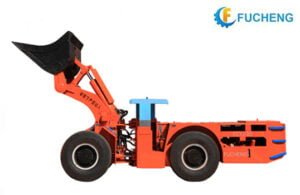
- The Fucheng underground LHD loader is a zero-emission machine that is friendly to the environment. The advanced high-quality purifier cleans the engine exhaust, making the underground tunnel comfortable to use.
- Scoop tram is ideally designed for underground applications of minimal height and width due to their low profile, lightweight, small, and long characteristics. Since the tunnel’s duration is unrestricted, a large enough reducer is needed. Improvements in the period, axis redistribution, and bucket capacity are also possible.
- Electric LHDs usually make very little noise. On the other hand, these vehicles are specifically built to fulfill the unique requirements of narrow vein mining.
- These underground LHDs have a strong braking force, a fast pedaling speed, and a unique roller filling feature that allows you to go more quickly.
- Underground LHD loaders are tough, fast, and simple to keep up with, allowing you to get the most out of your time on the job.
- The Fucheng Underground Automotive Production Business will provide consumers abroad with 24/7 after-sales support and service distribution. Several warehouses in the surrounding region offer accessible facilities.
- The underground LHD loader has a unique compact construction that allows for versatile service, high productivity, and low harmful gas emissions.
- The LHD shovel is constructed of wear-resistant steel and is used underground. As a result, both its longevity and appearance are crucial.
- Our underground LHD loaders are designed for high performance and low cost per ton of processing and finishing in underground mining applications. It has a lightweight, scalable efficiency, a strong structure, and easy maintenance, guaranteeing efficiency, long life, and low running costs.
- Underground LHD loaders would undoubtedly satisfy the requirements due to their high capacity, comfortable build, and long-term use.
- To ensure low life-cycle costs and high availability, Fucheng LHDs have undergone extensive training and testing.
- By integrating oscillation and articulation, the underground LHD Loaders have a central articulation joint that allows optimal maneuverability and versatility.
- The Fucheng Underground LHDs are outfitted with a variety of tools. These items are readily available on the open market. As a result, running these cars is convenient and straightforward.
- Due to technical advances, LHDs are eligible for remote control. In high-risk conditions, these LHD loaders are incredibly productive. Miners may use a computer to excavate minerals, similar to how they can participate in a video game.
Underground Scooping/Loading method
Initial Position → Pile location → loading pile → initial position → mining truck location → Dumping → Initial Position
- Underground mining scoop trams or loaders are two-way vehicles. According to the mining strategy, the above cycle is an underground LHD working method.
- First, the LHD can take a convenient distance to complete its working cycle smoothly, starting from the initial position.
- LHD then starts moving towards the Pile location and starts scooping.
- The piles come to their initial place and aim towards the dump truck or mining trucks. LHD then dumps the material from the bucket to the underground mining trucks.
- After dumping, It finally comes back to its original stage.
However, Underground LHD changed the engine direction front and back between this cycle. It used forward tracking while moving to pile and dump trucks. And while returning to the original place, it used moving backward tracking.
Underground LHD Loaders Precaution and Safety Management
Underground mining is a technical and often risky occupation. As a result, miners should always pay attention to the safety standards established by the mining company. In this section, Fucheng will guide you to more information on preventive measures in underground mining while running an underground LHD, in addition to the individual company instructions.
- Any individual who operates Underground LHD must have a valid driver’s license that is safe for the vehicle they are running.
- Operators of equipment shall perform pre-shift inspections according to the manufacturer’s orders to ensure that all protective equipment and operating functions are in order and work properly. Before returning the machinery to perform, a trained mechanic or technician must resolve any noted defects.
- Both mechanized vehicles must have operating and maintenance manuals stored in the truck.
- All Underground LHD loaders should have their swing range delineated and, if possible, secured so that any crush risks are protected from employees in the immediate region. Where required, barricades must be provided to restrict the work area.
- When moving machinery, supplies and products should be stored such that miners are not endangered.
- Any individual running an underground LHD must wear a seat belt.
- Flag persons/spotters that are well qualified and fitted may be needed when appropriate to ensure the smooth passage of LHD, such as aerial lifts, or to monitor the flow of hauling and dumping.
- Employees operating in the underground tunnel must wear high visibility (fluorescent green or orange)Class II protective vests at all times.
- Hard hats are often expected, while miners operating in or near LHD could risk overhead hazards.
- A permanently mounted working fire extinguisher is needed on all mobile gasoline or diesel-powered LHDs. ALL the LHDs must get their engines turned off before being refueled.
How to Maintain Underground LHD Loaders
If you regard repairing your vehicle as a high priority, you can get the most extended life from it. Additionally, the LHD can provide you with the best shot each time you drive your Underground LHD. The following are the basic maintenance guidelines Fucheng recommends you follow.
- Regularly maintaining the LHD is a necessity to have the vehicle’s entire, correct logs, and checklists. Through detailing the procedures involved in servicing each piece of machinery used for mining services and monitoring checks and maintenance, companies help maintain the usable life of vehicles in fleets of heavy equipment.
- Cleaning machinery regularly allows repair staff to maintain a closer track of the state of various objects. This procedure also leads to the presence of large vehicles on construction sites.
- Engines and motors in LHD typically need occasional servicing in addition to regular greasing and oiling. Following the manufacturer’s recommendations in this environment can help to protect the equipment and prolong its existence.
- The electrical wiring on LHD should be protected from the elements. For example, to avoid excessive wear and tear on the electrical parts, it might be appropriate to cover machinery with a safe protective tarp or to shield the equipment under a covering.
- At regular intervals, inspect the pieces of the equipment that come into touch with the earth. Debris, such as loose gravel, can get stuck in hard-to-reach places, and clearing helps the machines run more efficiently.
- During regularly scheduled LHD loader cleaning sessions, look for clear indicators of oil leakage. Owners of this costly equipment can procure required maintenance even more accessible by paying attention to potentially leaky pipes, aiding the machinery’s function.
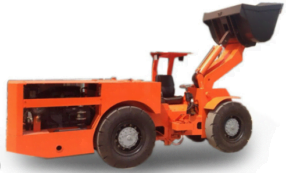
Summary
Underground LHD loaders, also known as underground mining scoop trams, are required for any underground mining activity. Based on the location of the pile, it may be either diesel or electric. On the other hand, Diesel motors are strong and flexible, while electric LHDs are reliable and cost-effective.
The LHD operator must be acquainted with all of the necessary precautions for the particular LHDs when operating inside an underwater tunnel. They should also know how to maintain the vehicle to get the best performance from the LHDs in charge.
However, Fucheng will still guide you to keep your underground LHDs well cared for. For any assistance, we are always available.

